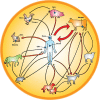Staphylococcus aureus in Animals
- PMID: 31124433
- PMCID: PMC11257167
- DOI: 10.1128/microbiolspec.GPP3-0060-2019
Staphylococcus aureus in Animals
Abstract
Staphylococcus aureus is a mammalian commensal and opportunistic pathogen that colonizes niches such as skin, nares and diverse mucosal membranes of about 20-30% of the human population. S. aureus can cause a wide spectrum of diseases in humans and both methicillin-sensitive and methicillin-resistant strains are common causes of nosocomial- and community-acquired infections. Despite the prevalence of literature characterising staphylococcal pathogenesis in humans, S. aureus is a major cause of infection and disease in a plethora of animal hosts leading to a significant impact on public health and agriculture. Infections in animals are deleterious to animal health, and animals can act as a reservoir for staphylococcal transmission to humans.Host-switching events between humans and animals and amongst animals are frequent and have been accentuated with the domestication and/or commercialisation of specific animal species. Host-switching is typically followed by subsequent adaptation through acquisition and/or loss of mobile genetic elements such as phages, pathogenicity islands and plasmids as well as further host-specific mutations allowing it to expand into new host populations.In this chapter, we will be giving an overview of S. aureus in animals, how this bacterial species was, and is, being transferred to new host species and the key elements thought to be involved in its adaptation to new ecological host niches. We will also highlight animal hosts as a reservoir for the development and transfer of antimicrobial resistance determinants.
Figures

References
-
- Devriese LA, Vancanneyt M, Baele M, Vaneechoutte M, De Graef E, Snauwaert C, Cleenwerck I, Dawyndt P, Swings J, Decostere A, Haesebrouck F. 2005. Staphylococcus pseudintermedius sp. nov., a coagulase-positive species from animals. Int J Syst Evol Microbiol 55:1569–1573 10.1099/ijs.0.63413-0. [PubMed] - DOI - PubMed

